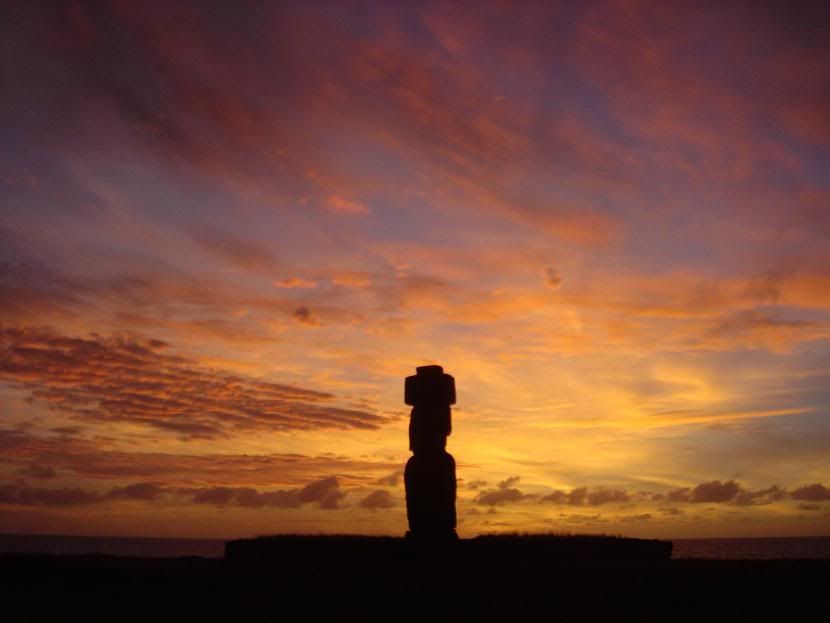
Rapa Nui, better known as Easter Island to the English speaking world, has been a dream destination of mine since I was young. From the first time I saw pictures of moai I wanted to visit, and South America gave me the opportunity to do just that. There is a certain air of anticipation and expectation when you reach places you have always wanted to visit - anticipation and expectation that can be crushed if it fails to live up to your imagination. The last place I visited with similar feelings was Angkor in Cambodia - which passed with flying colours.
Easter Island has the honour of being the remotest inhabited scrap of land in the world - the nearest landfall is the Pitcairn Islands, 2200km away, home to the Bounty mutineers, and the South American mainland is 3700km to the east. The island, about 20km along each side, is roughly triangular and was formed by 3 (now extinct) volcanoes in each corner of the island. It is inhabited by about 4000 people, around half of whom are original Rapa Nui islanders, with their own language - Rapa Nui - and very obvious culture.
It is both reassuring and a little lonely when first seen from the air - landing on the huge runway (the largest in South America, extended by the USA to allow emergency landings by Space Shuttles) after hours over water then taxiing to the tiny terminal feels like arriving in a friendly provincial town - except that all around the ocean. I found a cheap guesthouse on the coast in Hanga Roa, the only settlement on the island, and settled in get to grips with my new camera and hangover from clubbing in Santiago the night before.
I only had 4 whole days to explore the island, so the following morning I set off to walk around Rano Kau, the beautiful volcano crater close to the town, and look at the relics of the Birdman culture that flourished on the island in recent centuries. On my way I acquired a friendly dog that stayed with me the whole day whilst I completed my crater walk and first visits to ahu. The first called Ahu Vinapu, was unrestored and contained two ahu each with several toppled moai, complete with fallen red topknots. It was a sad and slightly eerie sight - the faces buried in the ground where they had been toppled years before.
Easter Island has worldwide fame for being the home of moai - huge stone statues that sit on ahu, ceremonial altars. It is now generally accepted that the island was first inhabited around 400 A.D. by Polynesians, who also introduced a variety of plants and trees onto the island. Within 300-400 years their culure had developed sufficiently to allow moai building to begin. It appears that the moai represented ancestral figures unique to each village or clan, mounted on their own ahu. After approximately 1000 years of stable society problems occurred - probably due in part to deforestation of the island, caused by use of trees as rollers to transport moai on, as well as overutilisation of their limited resources. There were a series of civil wars during which eventually all the standing moai were toppled - the last reported standing was in the 1830s and by 1864 there were none left upright. An alternative culture, based around warrior chief of clans, developed and became known as the Birdman cult due to the annual race to retrieve the first egg of the Sooty Tern laid on a small islet off the island.
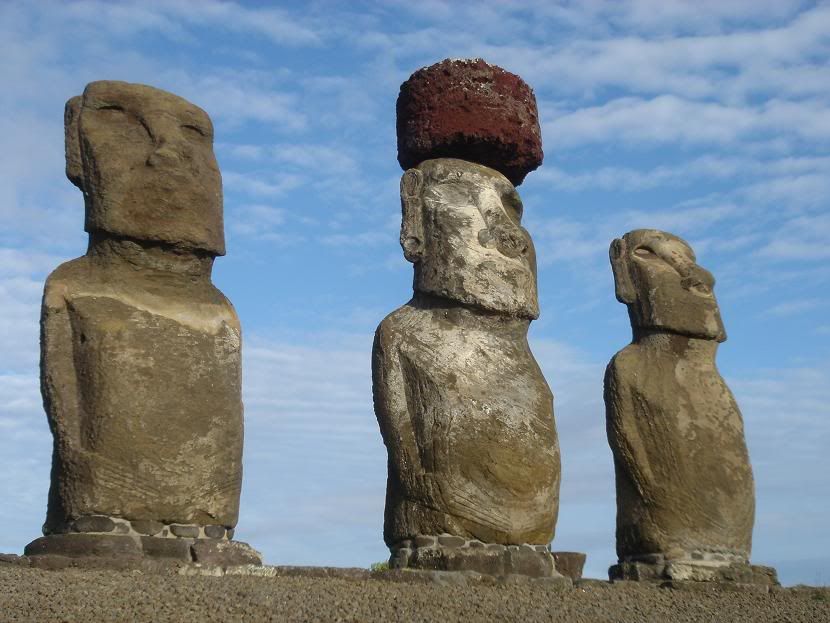
Three moai at Ahu Tongariki
Since the first Western contact - back on Easter Sunday in the 1722 - there has been a sorry tale of exploitation of the island and islanders; first as slaves in Tahiti, then the use of the island as a huge sheep ranch in the early 20th century. The population was stable at around 4,000 until the 1850s, when smallpox and emigration reduced the numbers to their lowest figure of 110. Tourism first started in 1967 with the opening of the airport, by which time several moai had been restored, and the island now depends entirely on tourism for it's tiny economy.
The following day I hired a jeep, with Jamie and Steph, 2 girls from my guesthouse, to explore the rest of the island. We started by taking the north-easterly coastal road, that passes a string of ahu, almost all of which were in a poor state of repair with absent or badly weathered moai. The island is volcanic and so the stone is fairly soft to carve - but degrades easily. Only one ahu, at Ahu Hanga Tee, had a row of face-down moai; the description, "Testatment to the destruction of the moai" said it all. We moved on to Rano Raraku, the quarry where the moai were mined and now almost 700 lie in partial states of completion. Perhaps the most perplexing part of the Easter Island story is why many so moai were left in the quarry - only about 200 were moved elsewhere - and some of those remaining are huge, up to 50 feet high. Why did the islanders continue in their production despite the continuing and worsening deforestation and food shortages? To me the quarry - birthplace of the moai - felt more life a graveyard and again, despite the sunshine, there was sadness along with the awe.
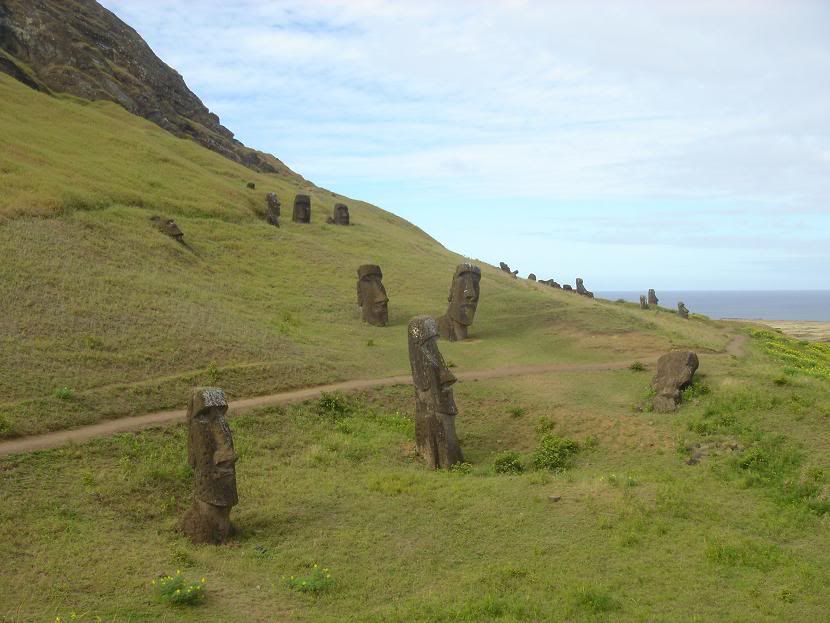
Rano Raraku, the quarry
We moved on to the largest ahu, restored with 15 standing moai, one of which sports a red topknot, representative of a mass of dyed hair. The site, Ahu Tongariki, was the most impressive - you cannot failed to be inspired by the huge figures with an impenetrable skyward gaze. We resolved to return for sunrise the following day before moving on along the north coast of the island. In Rapa Nui language the island is also known as Te Pito O Te Henua - The Navel of the World - and we stopped at the 5 rocks that represent this, before reaching the small, gorgeous beach at Ovahe, complete with pink tinged sand. Further on we came to Anakena beach and perhaps the most aesthetically pleasing ahu with restored moai - the white sand backdrop, palm fringed beach made the seven statues, some with topknots, almost surreal after the harsh volcanic beauty of Ahu Tongariki.
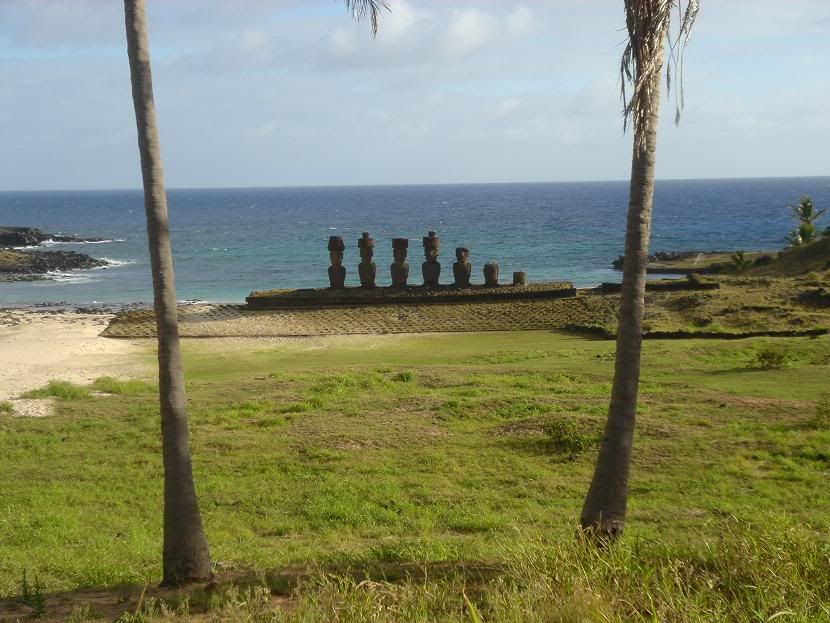
Ahu Nau Nau at Anakena beach
We visited Puna Pau, the other quarry on the island where the topknots were sculpted from red volcanic stone, before taking the western coastal road in the dark - another place to revisit.
The following morning we were alone at Ahu Tongariki for sunrise, and enjoyed the dawn in the cool damp air; there was something about Tongariki that kept drawing me back, and I wanted to return even after we had moved on to Anakena to spend some more time on the beach there.
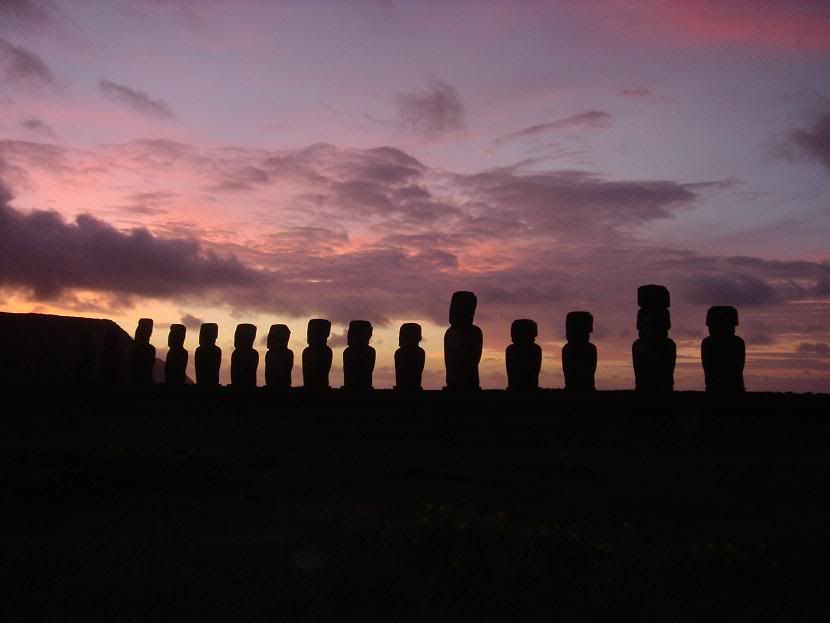
Sunrise at Ahu Tongariki
After relaxing on the beach we moved on to see what we had failed to the day before. First port of call was Ahu Akivi - an inland site featuring the only ahu with moai facing the sea. It had been well restored and without the continual crashing of the Pacific swell pounding the beaches close by, was a peaceful spot.
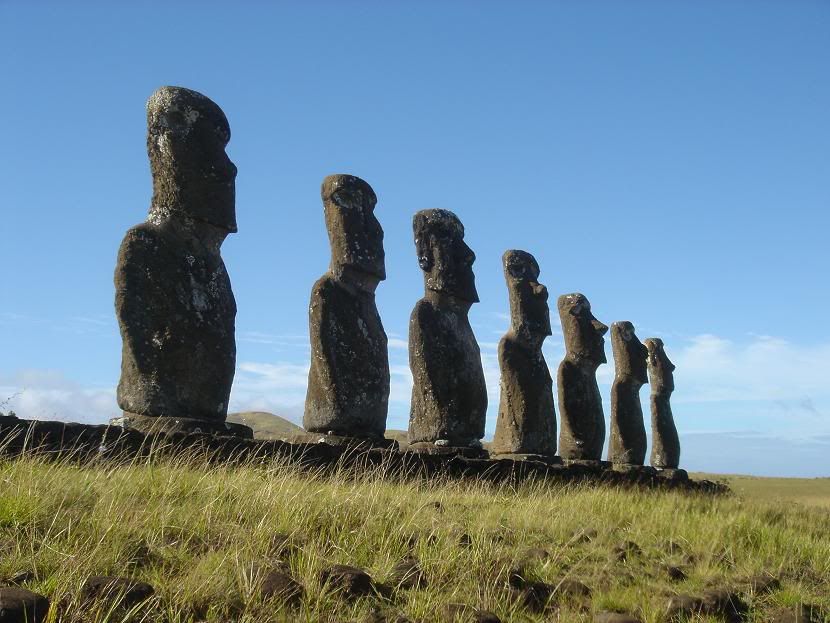
Ahu Akivi
Not all of Easter Island's attractions are moai related; the volcanic rock contains vast warrens of caves, several with openings to the sky. Amongst these the caves at Anu Te Pahu and Ana Kakenga were the most accessible and impressive - but to me they paled in comparison to the moai.
Just north of Hanga Roa, on the coast, sit several restored ahu that I visited at sunset. Tahai, containing 5 standing moai, was most impressive, but a little further on was Ranga Kio'e, a moai fully restored with red topknot, white coral eyes and red scoria iris and pupils. I'll let you make your own mind up about the sunset - sometimes it's easy feel a bit jaded.
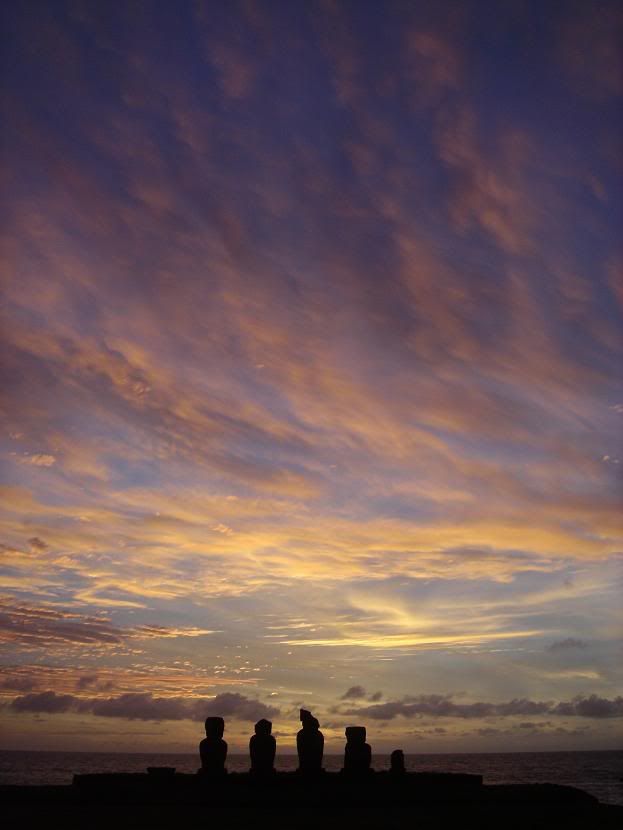
It was actually more beautiful in real life....
The following day was my last full day on the island, and after some souvenir shopping I hired a car again with the girls, to revisit some sites with the intention of a more relaxed exploration. First, though, we drove to the to the highest point of the island. From there we were able to see almost every point on the island, and the sea was visible on the entire horizon - it made me feel very small.
We returned next to the quarry, then Ahu Tongariki again - I couldn't get enough. On the way back to town we went to Ahu Vinapu - my first ahu, before heading up to Orongo, on the crater rim near town. Orongo is the site of the main Birdman relics - around a dozen small stone houses are built overlooking the Birdman Island, and petrogylphs litter most flat rock surfaces. It is a fascinating testimony to the ability of man to adapt culture depending on his circumstances - in this case done in the face of exhaustion of the island's natural resources. We watched the sun go down from Orongo -maybe like the Rapa Nui had done centuries before - before heading back into town.
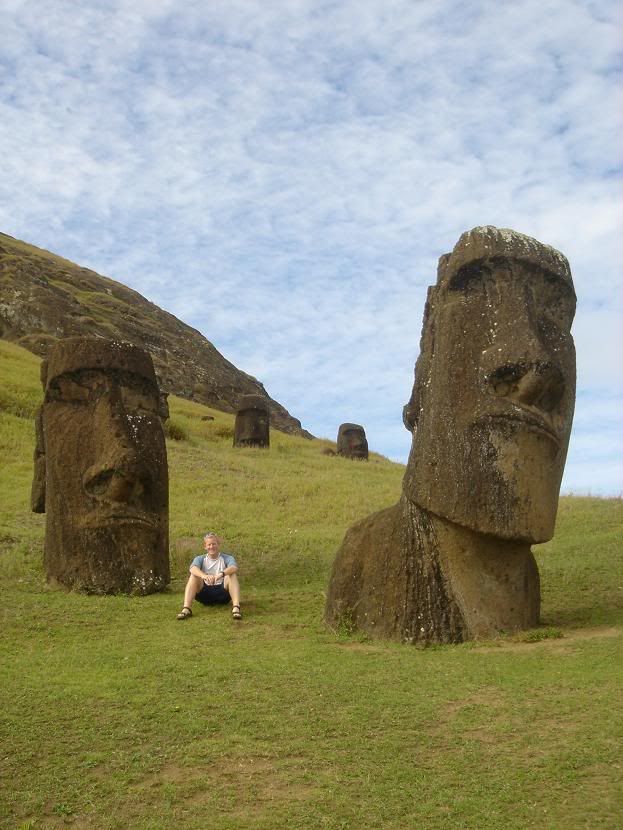
The following morning was my last on the island. With my last couple of hours I took Jamie and Steph up to Anakena - they were going to walk around the north western corner of the island whilst I returned to Ahu Tongariki just one last time before my flight left. The sunrise wasn't as good as the first, but there was the same air of tranquil calm guarding the site, and as I returned to the jeep I couldn't help but take some backward glances over my shoulder.
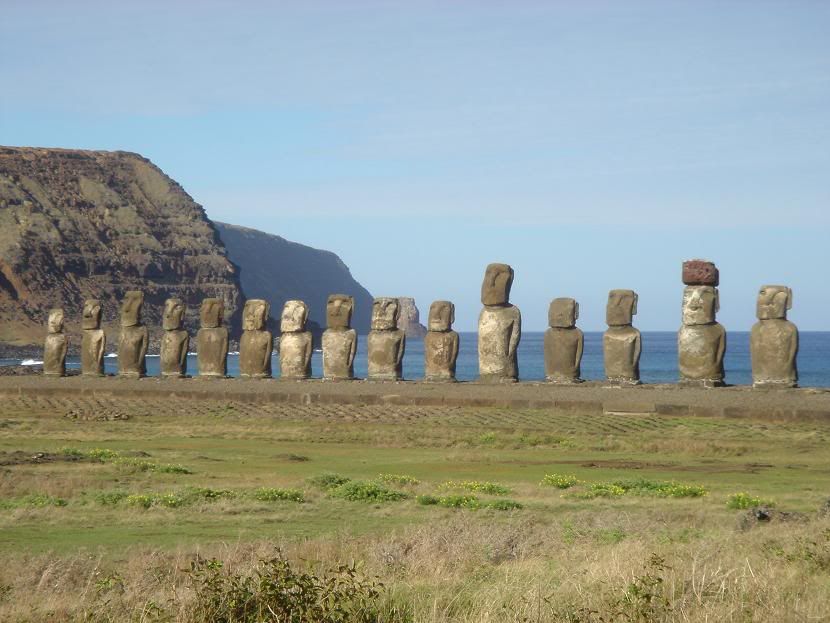

3 comments:
Simply awesome! Must book trip there now! Dave
Very well written Pete. I enjoy folowing your trip, as my own comes to an end. Leave Mendoza this Thursday for home, but will continue to follow your blog. You didn`t answer your own question..did it live up to your expectations?
cheers Ray
Excellent review Pete. Just finished Paul Theroux's book covering the South Pacific which sowed the Rapa Nui seed!! You just brought it to fruition!! I'm going!!!
Many Thanks,
Andy Scott (would you believe it, from Ormskirk and graduate of Liverpool Uni!!!! Must be in the water!!!)
Post a Comment